Artifacts
The following are artifacts recovered from the Jupiter Wreck.
Some artifacts are held by the State of Florida (not for purchase)
Latest find: July 2010 (see below)
Latest find: July 2010 (see below) Archives and research link these maritime remains to the Spanish "AVISO" vessel named "SAN MIGUEL DE ARCHANGEL," bound for Spain with its last port being Havana, Cuba. In December of 1659, the San Miguel foundered and wrecked off the "JEAGA" (Jupiter Inlet). The thirty-three surviving sailors lived with the local "JEAGA" native Americans until rescued by a vessel dispatched out of St. Augustine. The San Miguel de Archangel was one of the many ships lost carrying precious cargo of gold and silver to Spain. Modern archaeological recoveries included ships' rigging as well as Spanish coins and bullion, mined and minted in Potosi, Bolivia; Lima, Peru; Mexico City; and Bogotá and Cartagena, Colombia. There have been over15,000 artifacts, of which 12,000 coins (gold and silver, but mostly silver) recovered to date. One anchor and approximately 11 cannons. The State of Florida has received 20% of the recovered coins as well as first choice of the truly "one of a kind" artifacts. Two bullion bars were recovered, a 78 pound silver ingot, a 5 pound gold bar, and some of the rarest, coins ever minted.
July, 2010
pre-Colombian Native tooled shell: American artifact. "Gorget" made of marine shell is a sandal-sole type; the shape is similar to the sole of a shoe or sandal, although it is not flat but rather retains the curvature of the shell from which it was cut. Three unequally-spaced holes were drilled along the long axis. Two very small holes were drilled on either side of a small crack. At the margin on either side of the crack are a series of small incised lines. The shell is pale yellow in color.
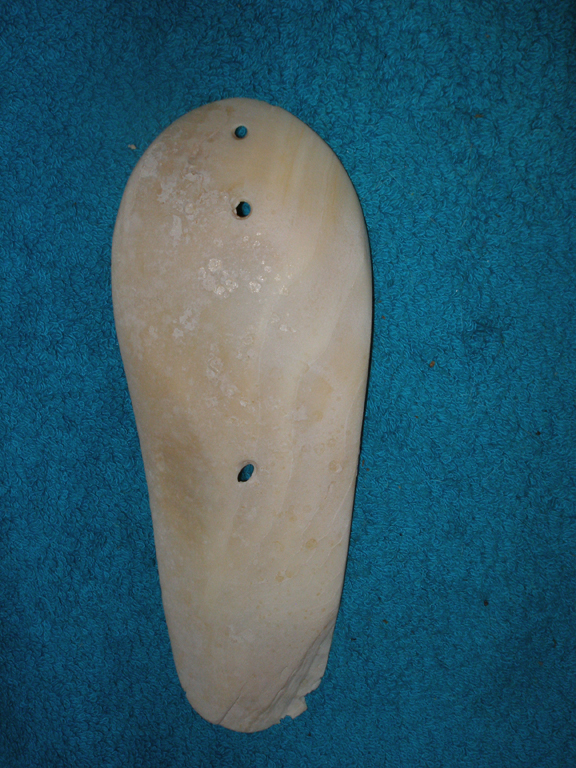
Possibly from the Glacial Kame
Possibly from the Glacial Kame Glacial Kame Culture The Glacial Kame Culture were Native Americans known as the Archaic peoples that occupied Southern Ontario, Michigan, Ohio and Indiana from around 8000 BC to 1000 BC. They got their name from their practice of interment of their dead on top of hills of glacial gravel. Burial sites included ornaments of copper and marine shells. Extensive trade networks existed at this time. Other regional cultures include the Maple Creek Culture of southwestern Ohio, Red Ocher Culture and Old Copper Culture of Wisconsin. Earl Townsend described it best when he wrote, "The term Glacial Kame Culture has been ascribed to the culture of the people who deposited certain burials and grave goods in the natural sand and gravel hills or kames formed by glacial action over a large area of the Great Lakes Region. Whenever skeletons are unearthed from a natural sand or gravel deposits, if three-holed sandal-sole gorgets of the marine shell, Bysycon perversum, are also found, the burial is assignable to the Glacial Kame Culture. In no other recognized classificatory archaeological unit do these type artifacts appear." The Glacial Kame Culture may have been an aspect beginning in the Late Archaic and continuing into the Early woodland period. In addition to the sandal sole gorgets, one can expect to find round three-holed shell gorgets, rectangular shell gorgets, crudely made copper beads, finely polished shell beads, stone gorgets, and pipes made of banded slate and limestone. For more information, click on this link: Glacial Kame shell gorget
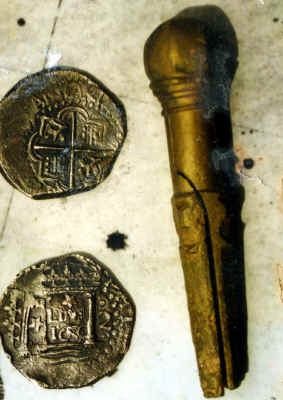
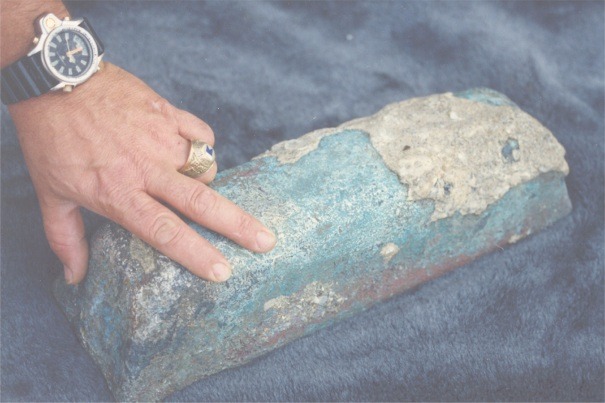
78 Pound Silver Ingot
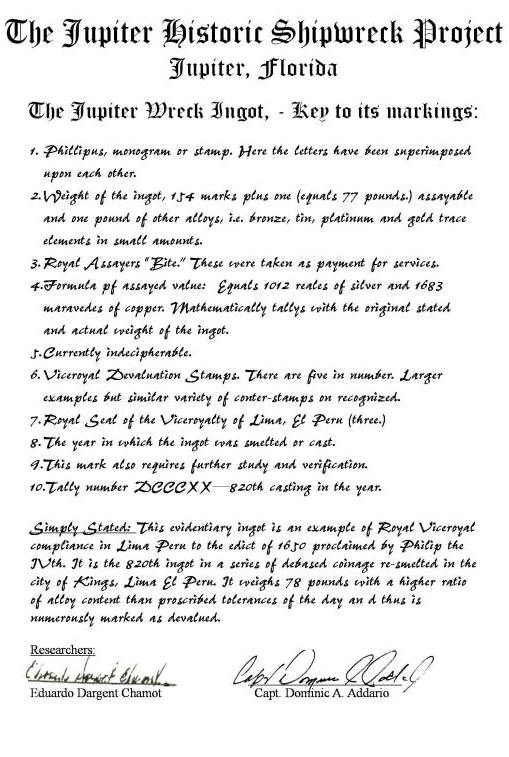
Some artifacts are held by the State of Florida (not for purchase)
Latest find: July 2010 (see below)
Latest find: July 2010 (see below) Archives and research link these maritime remains to the Spanish "AVISO" vessel named "SAN MIGUEL DE ARCHANGEL," bound for Spain with its last port being Havana, Cuba. In December of 1659, the San Miguel foundered and wrecked off the "JEAGA" (Jupiter Inlet). The thirty-three surviving sailors lived with the local "JEAGA" native Americans until rescued by a vessel dispatched out of St. Augustine. The San Miguel de Archangel was one of the many ships lost carrying precious cargo of gold and silver to Spain. Modern archaeological recoveries included ships' rigging as well as Spanish coins and bullion, mined and minted in Potosi, Bolivia; Lima, Peru; Mexico City; and Bogotá and Cartagena, Colombia. There have been over15,000 artifacts, of which 12,000 coins (gold and silver, but mostly silver) recovered to date. One anchor and approximately 11 cannons. The State of Florida has received 20% of the recovered coins as well as first choice of the truly "one of a kind" artifacts. Two bullion bars were recovered, a 78 pound silver ingot, a 5 pound gold bar, and some of the rarest, coins ever minted.
July, 2010
pre-Colombian Native tooled shell: American artifact. "Gorget" made of marine shell is a sandal-sole type; the shape is similar to the sole of a shoe or sandal, although it is not flat but rather retains the curvature of the shell from which it was cut. Three unequally-spaced holes were drilled along the long axis. Two very small holes were drilled on either side of a small crack. At the margin on either side of the crack are a series of small incised lines. The shell is pale yellow in color.

Possibly from the Glacial Kame
Possibly from the Glacial Kame Glacial Kame Culture The Glacial Kame Culture were Native Americans known as the Archaic peoples that occupied Southern Ontario, Michigan, Ohio and Indiana from around 8000 BC to 1000 BC. They got their name from their practice of interment of their dead on top of hills of glacial gravel. Burial sites included ornaments of copper and marine shells. Extensive trade networks existed at this time. Other regional cultures include the Maple Creek Culture of southwestern Ohio, Red Ocher Culture and Old Copper Culture of Wisconsin. Earl Townsend described it best when he wrote, "The term Glacial Kame Culture has been ascribed to the culture of the people who deposited certain burials and grave goods in the natural sand and gravel hills or kames formed by glacial action over a large area of the Great Lakes Region. Whenever skeletons are unearthed from a natural sand or gravel deposits, if three-holed sandal-sole gorgets of the marine shell, Bysycon perversum, are also found, the burial is assignable to the Glacial Kame Culture. In no other recognized classificatory archaeological unit do these type artifacts appear." The Glacial Kame Culture may have been an aspect beginning in the Late Archaic and continuing into the Early woodland period. In addition to the sandal sole gorgets, one can expect to find round three-holed shell gorgets, rectangular shell gorgets, crudely made copper beads, finely polished shell beads, stone gorgets, and pipes made of banded slate and limestone. For more information, click on this link: Glacial Kame shell gorget
A sample of 2 - 8 Reale's dated 1659 from Lima, Peru
Note: The magi star.
These were some of the most valuable coins aboard the vessel
Divider (calipers)
which were used to measure nautical distance
Note: The magi star.
These were some of the most valuable coins aboard the vessel
Divider (calipers)
which were used to measure nautical distance

78 Pound Silver Ingot
Captain Dominic Addario discovered and recovered the only silver bar yet recorded, numbered 820 off the Jupiter Wreck. The original was donated to the Florida Historical Resources in Tallahassee, Florida after this cast was taken.

Be sure to visit the ships store for authentic shipwreck coin artifacts!
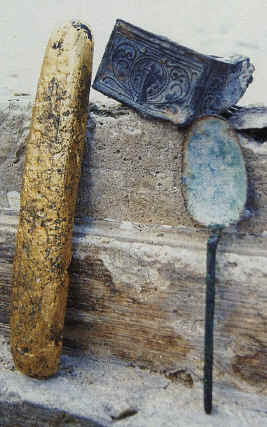
Spoon, Pewter Shaker Box and a Copper Bucket (not shown)
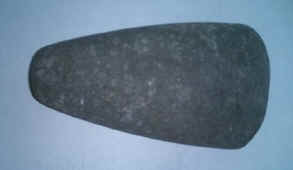
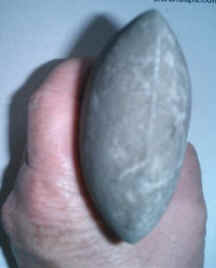
A Stone Age Axe Head found by Captain Dominic Addario while a guest, diving off The Seahunter in 2006. The edge is so sharp that it actually cut Captain Dom's finger
Spoon, Pewter Shaker Box and a Copper Bucket (not shown)


A Stone Age Axe Head found by Captain Dominic Addario while a guest, diving off The Seahunter in 2006. The edge is so sharp that it actually cut Captain Dom's finger